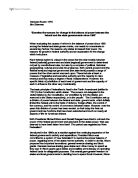This is also known as layer-cake federalism. Duel federalism continued until the great depression where a huge amount of expectation came on the federal government, to deal with the major economic problems countrywide.
F. Roosevelt set-up alphabet agencies and grant-in-aid schemes. This created a huge expansion of federal and state government. FDR’s new deal entailed a shift of some responsibility to the federal government, for the reform of banking and finance to relief economic hardship.
Although there was wide spread support of FDR’s proposals, the Supreme Court declared some of his most important policies as an unconstitutional expansion of presidential authority, such as The National Industrial Recovery Act of 1033, which was struck down in Scheichter v. US (1935) and the Agriculture Adjustment Act of 1933 in US v. Butler (1936)
FDR threatened the court with his Court Packing Plan, which helped him secure further policies such as the National Labour Relations Board v. Jones & Laughlin (1937) this became considered a turning point in the federal state relations, for the first time the Federal government was allowed to intervene in state affairs. This period became known as Co-operative Federalism.
Later in the 1960’s the federal government took on new responsibilities, such as social and welfare issues, known as Presidents Johnson’s Great Society, involving increased welfare provision through Medicaid and Medicare, his vision was an America, free of socials ills, such as poverty, squalor, ignorance, fear or hatred and where the quality of life opened the door for all Americans; “For the first time in world history, we have the abundance and ability to free every man from hopeless want” L Johnson 1964.
Again this cause another large rise in the federal budget, and bureaucracy, where planning and funding came from central government and implementation was carried out locally. This was a more active form of co-operative federalism, Johnson called it creative federalism as Washington would seek out and respond to local ideas and demands.
The ‘creative’ 60’s brought complaints from states, that didn’t like being told how to spend federal grants.
This caused a change of tide in the Federal-State relationship. Republican presidents, particularly R. Nixon (69-74) and R. Reagan (81-88) became attentive to states demands and discretion was given in spending money granted to them.
Nixon created a New Federalism by creating a ‘General Revenue Sharing’ scheme, which give a proportion of federal grants to the States and local governments, this was to be spent on infrastructure, communications, environment and on public safety, but the states had a powerful say in how the money was used. He claimed that federal government programmes encouraged state government to accept funding for programmes that they did not really need or want.
Reagan continued to change the Federal/State relationship, by adopting Nixon’s ‘New Federalism’ legacy, he reduced the size of Federal government, and gave States further Federal responsibility on issues such as Food Stamps and welfare. This slashed his Federal spending bill and impacted schemes such as Medicaid - This was conceptually a return to Duel Federalism.
Consequences are being noticed, now that States have lost Federal revenue, and most States have an unconstitutional budget-deficit. Causing States to raise its own income by raising taxes, and cutting spending. Showing that states had become subordinate to the needs of national government.
Today State power is an significant force, with the power to control elections and law enforcement, they are responsible for public education and transport, and they set their own tax rates, as shown in the 6th Amendment.
To conclude the influence of Federal Government has been strengthened throughout, through its increase in budget, personnel and military; becoming vitally important to the well being of the people. The Supreme court being the arbiter of disputes between State/Federal, has often permitted a considerable increase in the size of national intervention, by emphasising the broad and permissive character of the clauses in the constitution, however the Federal relationship has always avoided becoming unitary, so allowing acceptable degrees of state independency.







